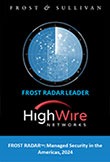With the exponential increases in cyberattacks and the shortage of cybersecurity expertise, it’s not easy for businesses to stay a step ahead of cyberthreats. That’s where Security Orchestration, Automation and Response, or SOAR, comes in.
SOAR collects threat data, alerts security teams and automates responses. It goes a step further, using artificial intelligence (AI) to learn and predict threats. SOAR can help to prevent threats from reaching people or systems in the first place and also help to isolate and remediate the threats that break through. Most importantly, SOAR makes it possible for security teams to keep pace with the escalating volume and variety of today’s cyberthreats.
In this guide, High Wire Networks offers an overview of SOAR, its features and functionality, and the attributes you need in a SOAR security vendor.
What is SOAR?
SOAR stands for Security Orchestration Automation and Response. It refers to a strategic stack of security software and services that helps organize data on cybersecurity threats and respond to those threats, either preventatively or to events, automatically. Here’s how each component breaks down:
What is Security Orchestration?
Security orchestration significantly boosts threat intelligence by collecting and processing decentralized threat information from disparate systems, applications and devices to develop a superior, unified front against cyberthreats. Inputs include external data resources such as threat libraries and databases and real-time global threat feeds as well as internal (or internally sourced) resources and tools, such as endpoint detection and response (EDR) and extended detection and response (XDR), firewalls, user behavior analysis, intrusion detection systems and more.
What is Security Automation?
As its name suggests, security automation refers to automated responses to threats. Within the SOAR framework, this automation typically consists of triggers and actions in response to threats uncovered in security orchestration. Advanced security automation solutions leverage artificial intelligence (AI) and machine learning (ML) to:
-
- Better screen the higher volumes of data and potential “false positives” flagged by the orchestration layer
- Contain and remediate identifiable threats when possible
- Advance remaining threats to human experts for analysis and remediation
What is Security Response?
In SOAR, the Security Response layer refers to all the components necessary to respond to threats—from planning and analysis to threat remediation, reporting and post-event activities. These responses are typically coordinated and delivered from a proprietary or managed security operations center (managed SOC) and predefined through a cybersecurity incident response plan.
SOAR vs. SIEM
SOAR is sometimes erroneously confused with Security Information and Event Management (SIEM). While the two technologies share some similarities and are in some ways complementary, SOAR delivers a more comprehensive approach to threat mitigation through extensively planned actions (“workflows” or “playbooks”) in response to detected threats. In some cases, existing SIEM systems including next-gen SIEM (as some industry leaders refer to Open XDR) provide inputs used in SOAR’s orchestration operations.
SOAR Tools & Features
SOAR “tools” are best defined as actions and responses that provide intelligence and analysis responses that feed workflows and playbooks. (Note: Playbooks are composed of workflows that accomplish objectives). SOAR tools address unique situations (see SOAR Use Cases below) by bundling analysis, automation, SOC services and other responses. Predefined plans handle a variety of scenarios, ranging from automated patching, threat intelligence and incident response to deep-dives like phishing investigations and threat hunting.
Better, Faster Everything: Benefits of a SOAR Platform
SOAR platforms are quickly emerging as best-in-class solutions because of their impact on critical cybersecurity initiatives. In effect, SOAR makes these security strategies better or faster. Here are some examples:
Unified, integrated security:
- SOAR integrations empower holistic security and resilience across all focal points, including:
- Analytics and data
- Cloud infrastructure
- Email systems and accounts
- Endpoints
- Forensics
- Identity (and access) security
- IT operations and infrastructure
- Malware analysis and mitigation
- Network infrastructure
- Risk management
- Threat intelligence
- Vulnerability testing and assessment
Smarter threat intelligence:
Centralized data inputs, including internal sources and external threat feeds, lead to more comprehensive threat screening, analysis and identification.
Faster response times:
The combination of better threat intelligence and automation reduces the time to identify and respond to potential threats, real threats and incidents.
Better incident containment:
SOAR’s intelligence and automation intelligence help better isolate compromised endpoints, user accounts and apps before threats can proliferate across other infrastructure points.
Faster recovery times:
Enhanced threat intelligence and automation reduce the time to identify and respond to potential threats, real threats and incidents.
Stronger incidence and remediation communications:
Automation, integration and templates can facilitate faster and more cohesive communications between security personnel and key internal and external contact points.
Lower cybersecurity and resilience costs:
SOAR reduces costs on five fronts:
-
- Prevented breaches/incidents directly translate to avoided costs of downtime and recovery (and potentially ransom payments).
- Faster incident mitigation and response lessens downtime and recovery costs.
- Operational streamlining through workflows and playbooks cuts operational and personnel costs.
- Automation reduces both the number of analysts/specialists needed and high turnover from burned-out security personnel, decreasing personnel and HR costs.
- Automated logs and templates lower reporting costs.
Process standardization and streamlining:
Automation, workflows and playbooks – and the exercises required to create them – lead to the standardization of processes, which has many positive benefits on direct and indirect costs (e.g., the personnel impacts) and operational speed before, during and after incidents.
SOAR Use Cases
SOAR systems can address a wide range of scenarios and objectives, depending on an organization’s needs. They also can be simple automations and routines that save time (e.g., automated patching) or complex remediation practices (e.g., end-to-end EDR management).
Although use cases can be quite detailed, they generally fall into three primary categories in line with the SOAR acronym and definitions:
Orchestration:
System, tool and feed connection, consolidation and coordination can drive significant improvements in monitoring analysis and reporting. Common use cases include improving threat identification and enhancing threat intelligence.
Automation:
SOAR-based automation can address everything from patching and employee/user onboarding and offboarding routines to contextual incident response, remediation validation and reporting.
Response:
Automated and human triggers and actions can create tickets, facilitate systemwide threat response hardening and suspicious or compromised email deletion, quarantines, automatically block threats, generate targeted alerts, conduct phishing email investigations, create and facilitate communications, and much more.
What to Look for in a SOAR Vendor
SOAR security vendor solutions should be API-centric and deliver end-to-end orchestration, automation and response via a single provider anchored in market-leading tools. The war against cybercrime is, in many ways, an arms race. You need a leader, not a laggard.
MSPs and MSSPs should select a provider partner with:
- Vendor neutrality (assures maximum integration opportunities and eliminates adversarial relationships with integration partners)
- MITRE ATT&CK capabilities for greater visibility and more focused workflows via orchestrated threat hunting, tracking, correlating and reporting
- Playbooks designed and prebuilt for – and drag-and-drop customizable by – SOC analysts to reduce response time by 70%
- Event pipeline processing for automatic data normalization, tagging, analysis and false-positive dismissal that scales on-demand
- Best-in-class case management for cross-functional team collaboration, data and threat visualization, tracking and investigations enriched with timeline views of events, incidents and artifacts
Most importantly, you need a partner with a deep commitment to the channel and an experienced channel team that can integrate with your clients’ solutions and delineates between your clients in SOAR workflows and playbooks.
Ready to take your MSP to the next level?
Discover how High Wire can help you SOAR!








